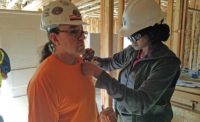Last year, OSHA implemented new rules on exposure to crystalline silica. The Permissible Exposure Limit for workers was essentially cut in half. It appears OSHA inspectors will be focusing on construction sites and dust clouds will likely be the focus for OSHA. Since silica is pretty common and OSHA fines are increasing, it might be advisable to find out more about this rule. Some in the wall and ceiling industry are simply unaware of the new rule. Some feel the rule will be overturned. But what if it is not overturned? Consider that our new Labor Secretary may have bigger issues to face. I suspect if fines are handed out, many may wish they had taken some progressive steps or actions. There are some steps that could save a contractor from being automatically fined.
The OSHA representatives will certainly be trained on the rules, procedures and what red flags to look out for. I know this because I have attended classes on the issue and know most states are gearing up for enforcement to start this June. The red flag will be dust clouds on project sites. They will be most focused on “enclosed” spaces. Respirable silica and the permissible amount or PEL is 50 microns per cubic meter of air in an eight-hour time weighted average.
Ways to Measure Microns
How much is 50 microns? A cup full? A teaspoon full? Consider a human hair is about 50 microns wide, so if you cut a human hair the same length as its width, that is your new PEL. If you have read hygienist reports that state units in MG, that is not a micron. There are 1,000 microns in one milligram or MG. This information should grab your attention now if you saw a report with 0.60 MG and thought you were way below 50.
In reality, that is 600 microns and over ten times the PEL. A few years ago, a colleague told me he did not want to know this kind of information. He believed that ignorance was not only bliss, but also a good defense. I wish people luck who believe in taking that approach.
For those who prefer to be proactive, you should be reviewing Safety Data Sheets of products you use and look for crystalline silica content. Construction products that commonly contain crystalline silica are cement mortar, concrete, aggregates, plaster, drywall and some joint compounds.
As an executive and editorial director, I feel it is my duty to be informed on the issue of respirable silica dust, the new OSHA rules and pass along that information to those who entrust me to keep them informed. I have discovered that not only will the problem not be solved on the golf course but strongly believe ignoring the issue will be problematic. My staff and I prepared an Exposure Control Plan for dust that was tailored for an industry that grinds aggregates, some of which contain silica. OSHA requires each company to prepare a written plan. Meetings with OSHA have revealed they encourage industry groups to implement specific plans tailored to the tasks and products in their industry. They also accept objective data collected by trade groups to customize respiration protection for each task and material.
The ruling is not that complex: there are basic exposure and action level limits. The confusion is in compliance to the rule. My staff and I had many disagreements in meetings as to what is a violation to what constitutes compliance. Even the micron to milligram issue created debate for some time. We had lab-certified air monitoring reports from some impressive projects; such as major airports, CIA headquarters and the Pentagon with data that added more confusion than clarification on exposure levels. Turns out, terminology can differ among scientists as much as contractors. I discovered having an in-house chemist on my staff was very useful in deciphering this language.
The new rule is coming. To stop it will require some action and that may or may not happen. The question you have to ask yourself is if you feel lucky. For those in states where a “dust exemption” was granted to drywall and plastering trades a decade back, this is a new ball game as it is not just dust, this is silica exposure. I know some states are grappling with what to do. I also know groups like CAL OSHA have not been able to provide a definitive answer on what they will do with regard to enforcement as I write this. I tend to find being prepared tends to lead to more and better luck. It took our staff some time to prepare an Exposure Control Plan and we are currently educating our members and it is a task. I would recommend every contractor to look up the “Small Entity Compliance” from OSHA to get educated.





